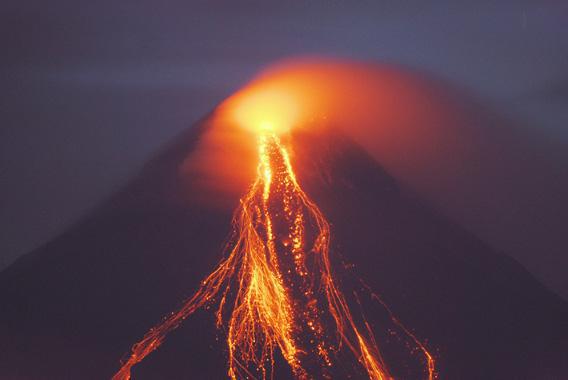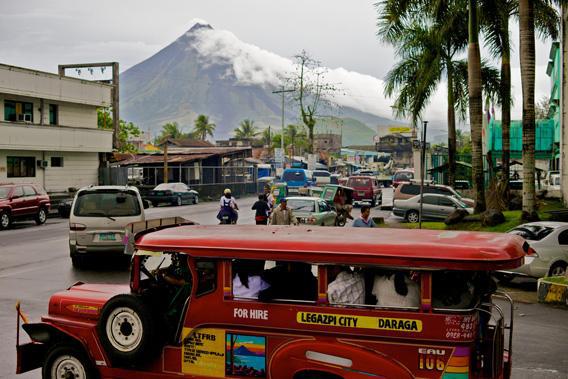LEGAZPI—It’s hot in the volcano observatory, really hot. Morning sunlight blasts a room of old-fashioned computer terminals and rolls of paper traced with seismographic curves. But Ed Laguerta, the resident volcanologist here at Mount Mayon, isn’t uncomfortable. He’s aimed the only fan in the office at one of his computers.
Through a bank of windows we can see the landscape that sits atop the most active magma chamber in the Philippines. It’s a cauldron of hot minerals covered over with alternating layers of cinders, ash, and lava, and encased in a picturesque mountaintop that looks like a rubber stamp on the horizon. Mayon is a stratovolcano, like Fuji and Vesuvius, and shares their iconic profile: sloping, symmetrical sides with a neat divot at the top. Ed and his employees are here to keep track of any rumblings in the ground beneath it and to check a set of GPS sensors embedded in its sides. If the volcano were about to erupt, the mountain would distend and the sensors would drift a few millimeters on a tide of swelling rock. Then Mayon would explode in a fiery avalanche of debris—a deadly lahar that steamrolls everything in its path. That’s what happened in 2000, and again in 2001, and then twice more in 2006 and 2009. The most recent eruption isn’t quite over, Ed tells me. The crater still glows at night.
I’d planned to climb the volcano and visit its orange rim, but Ed’s not so sure that’s a good idea. During the ‘06 eruption, hundreds of foreigners slipped through security checkpoints to scale the slopes in spite of official warnings. The local governor told reporters, “I’m afraid to say that the first violation of the zero-casualty record we have so far will be a dead tourist.” It’s not quite so dangerous today, Ed tells me. The mountain is at Alert Level 2: A full-scale Plinian eruption may be unlikely, but smaller events would be very hard to predict. The trail gets steeper as it approaches the summit, so even if you’re not worried about clouds of poison gas or sudden explosions of hot ash, there’s always the danger of falling rocks and slippery, rain-soaked rubble. “Some courageous tourists go to the crater,” he concedes, “but it’s up to you to take the risks.”
Twenty years ago, Ed was stationed at Pinatubo, and it was thanks in part to his work that tens of thousands of people were successfully evacuated from Angeles and elsewhere. “We were jubilant,” he says, recalling the tragic eruption. “Not because people were hurt but because we were right. We lifted our arms in the air!” If I tried to climb Mayon against his advice, I wonder, would he raise his arms in triumph upon my fiery death?
Here’s a stat I found before coming over to the Philippines: Over the course of the 20th century, around 100,000 people were killed by volcanic eruptions—an average of three per day. Go back a little further, and the numbers get bigger: When Iceland’s Laki volcano erupted in the summer of 1783, the resulting ash cloud killed off one-fifth of that country’s residents, along with an estimated 23,000 Britons. The latest models say that if Laki went up again, its spreading pollution would kill 142,000 across Europe.
“I’ve climbed all of them,” Ed told me, spreading his skinny hands out wide. “Mayon, Pinatubo, Balusan, Kanlaon.” A few decades ago, he dared to visit the most active craters in the country. “But not anymore. That’s for adventurers, for younger people. For older people—remote sensing.”
***
I’m at the local tourist office the following day, being waited on by a staff of seven. They have no other customers, and everyone’s trying to set me up with a mountain guide for a trek up the volcano. I’ve decided to park on the couch until someone can convince me that a “mountain adventure” won’t turn me into a pile of ash.
The first guide I talk to is Adrian. “Yes, there’s a danger of flash floods and poison gas,” he tells me over the phone, “but … maybe not too dangerous.” He promises to text me with a more detailed risk assessment as soon as he can, and then we’ll meet in person to work out a price. Later I discover that one of his company’s clients had been airlifted off the mountain by the Red Cross the previous week.

Photograph by Omeo Gacad/AFP/Getty Images.
Henry is my second option, a pudgy, smiley fellow who doesn’t look like he could trek my fourth-floor walkup in Brooklyn. There’s no mention of the slippery rocks or sulfuric clouds, but he does warn me about razor-sharp leaves lining the mountain trail. Indeed, his forearms are covered with scabs and scars. We have a short discussion about “assaulting the summit,” which sounds like an increasingly bad idea the more we talk about it. (Couldn’t we try negotiating with the summit first?) After some back-and-forth over the price, I take his phone number and say I’ll be in touch.
Then the head tourism official has an idea. “Let’s call Sheen,” she says. “She’s a girl, but she’s one of our top two tour guides. … No, wait, she is number one!” As she dials Sheen from the office phone she puts a hand over the mouthpiece and offers me a caveat, sotto voce: “She is … hmm … boy-ish. But she is married, so OK!”
When Sheen arrives in the office, she’s perfectly feminine—and otherwise an intelligent woman who speaks impeccable English. She’s brought her husband, Jo, the guy who’d take me up the mountain. When I relate what Ed Laguerta told me at the observatory, Jo erupts with comforting words. “It’s very safe,” he insists, sidling up on the couch. And then, to prove his point, he pulls out a digital camera and shows me a series of snapshots of himself at the crater, flexing and grinning and giving a big thumbs-up.
I tell him that I’m an amateur climber, and a little nervous. He’ll keep an eye on me, he says. He touches his chest in a solemn gesture, and declares that he has “the heart of a mountaineer, and a passion for reaching the summit.” I point out that this particular summit could start spewing lava at any moment, and that I have the heart of a florist and a passion for surviving the next 48 hours.
Jo grins, stretching the wispy hairs of his goatee. I chew my lip. We’ve reached an impasse.
Though my fears haven’t been assuaged, I trust Jo and Sheen. Maybe it’s that they’re demanding three times more money than anyone else. These are people who won’t cut corners—absolutely no bargain tours or discount rates, they tell me. I like that: If we’re going to die tomorrow, it should be a top-shelf experience.
